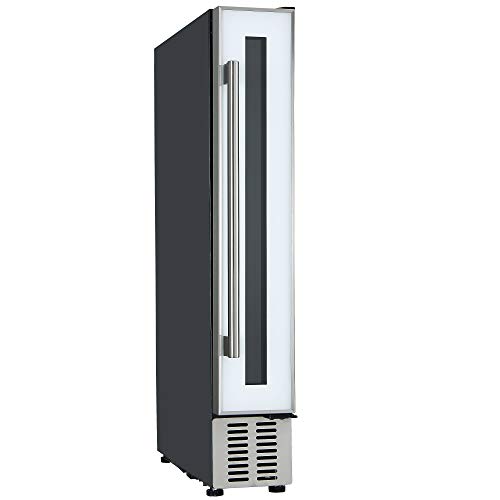Could Wine Fridge Cooler Be The Answer To 2024's Resolving?
페이지 정보

본문
 The Benefits of a Wine Fridge Cooler
The Benefits of a Wine Fridge Cooler A wine fridge cooler keeps bottles at the perfect temperature for maturing and reaching their full potential. A wine refrigerator that is well-designed controls humidity levels in order to prevent corks drying out and becoming oxidized.
A wine fridge cooler keeps bottles at the perfect temperature for maturing and reaching their full potential. A wine refrigerator that is well-designed controls humidity levels in order to prevent corks drying out and becoming oxidized.Choose a tall wine refrigerator fridge with multiple temperature zones. This is a great option if you have a variety of wines that require different storage conditions.
Compressor-based cooling
Wine fridge coolers make use of compressor technology to keep your wine at the ideal temperature for serving or long-term storage. This type of cooling system can be found more often in beverage refrigerators. It offers the same temperature throughout the refrigerator.
Freestanding or built-in wine refrigerators that make use of this cooling technology can be fitted to your bar, kitchen, wine cellar, or closet. They can be placed under counter or concealed, and in a lot of cases, they have front-facing ventilation to blend in seamlessly with other kitchen appliances.
In addition to keeping the proper temperature, wine refrigerators that use this cooling technology can also perform other important functions for storing wine. For instance, they can be equipped with a humidity control system that checks the air inside the refrigerator and adjusts the flow of water to ensure that the wine bottles are properly humidified. This helps prevent oxidation, which can affect the flavor of the wine.
Certain wine coolers feature dual or even triple temperature zones, which means you can store various types of wine at the right temperature. This is a great choice for those who like serving both white and red wines, or who want to divide their wine collection into different storage categories.
Certain wine refrigerators utilize this type of cooling to create the wine with a UV-resistant glass door that protects the cheap wine Fridge from harmful UV rays.
Wine refrigerators with this technology are typically quiet, and they produce no vibrations. They do not use liquid refrigeration and thus do not have moving parts that vibrate or cycle when they are running. This helps reduce vibrations that could cause loose hardware and other issues in the wine fridge cooler. It also helps reduce the sound generated by the cooling system and ensure your wine tasting at its best.
Thermoelectric cooling
Thermoelectric coolers are a different technology from compressor-based units. The Peltier effect is utilized to keep wine bottles cold instead of refrigerants. This occurs when an electric current runs through two pieces of metal joined, causing one side to get warmer while the other gets colder. This difference in temperature is what allows the cooler to maintain a the temperature inside the cabinet.
In the majority of cases, the cooler will employ an air source to distribute the cold air throughout the interior of the cabinet. It is typically an aluminum piece that has been electrolyzed that expands its surface to help disperse heat. The cooling process is assisted by fans positioned at each end of the heat sink to assist in circulation and ensure the wine stays at a constant temperature.
This technology is environmentally friendly. Thermoelectric coolers are environmentally friendly since they don't require refrigerants. They are also less expensive to run and use less energy than compressor-based coolers.
It is vital to remember that compressor units are more effective in keeping wine bottles at an optimal temperature than thermoelectric wine coolers. This is due to the fact that they're unable to reach the temperature they should be. They also require more maintenance since they are constantly running.
In addition to their eco-friendly and energy efficient capabilities thermoelectric wine refrigerators are also quiet. This makes them a fantastic choice for those who reside in restaurants or homes where it is crucial to maintain the atmosphere of the area. They are also great for living rooms where people love to entertain guests or have a glass of wine on their own. This is because they can be placed in any room in the house or restaurant without causing disturbance. This is because they don't depend on any motors or compressors that can be noisy.
Humidity Control
Wine is a sensitive product to environment and requires specific conditions to properly age. Temperature and humidity are essential for this process in order to maintain cork integrity and quality as time passes. A wine refrigerator maintains an optimal temperature range and regulates humidity to ensure a perfect ageing process.
The ideal level of humidity for storing wine is between 50 and 70%. When humidity levels drop the wine will lose its flavor and cause the oxidation. Mold and mildew can also thrive in extreme humidity, which can damage labels or affect the quality of cork. Wine fridges create an environment that hinders the growth of mold and mildew while preserving the appearance and flavor of wine.
Many wine refrigerators come with humidity control systems which regulate and maintain proper humidity levels. These systems use an inbuilt hygrometer which monitors the ambient air in the cheap wine coolers refrigerators cellar, and automatically adjusts the humidity settings to ensure that it stays within the desired range.
Additionally, some wine fridges have internal fans that facilitate the circulation of air and stop pockets of warm or humid air from developing. This helps to maintain consistent conditions throughout the wine storage area and also reduces energy usage by limiting fluctuations in the temperature of the fridge's operation.
Additionally, the majority of wine refrigerators come with doors made of solid or dual-paned which provide insulation and protection from harmful UV rays which can degrade compounds in the wine and alter the taste. Some models also come with vibration reduction mechanisms to reduce disturbances that can cause sediment to break in older bottles and alter the aging process.
While passive cooling techniques are effective for reducing humidity, you may require introducing additional moisture in your wine refrigerator if it has been operating in inadequate conditions for a long time. In the short term, you can use air dehumidifiers and moisture absorbers that are composed of crystals or mineral salts to absorb water vapour that is in the air. These devices should be emptied regularly and replaced. If you're seeking a long-lasting solution, you could consider installing an active humidity control system made up of an evaporator module for water atomizers and water tank.
Capacity for Storage
A wine fridge can be an excellent asset if you are a regular wine drinker and would like to keep a few bottles available for any unplanned or unexpected occasions. These devices recreate the optimal conditions of natural cellars and caves so that your wines can be able to develop their best flavors over time.
Wine is a delicate mix of various compounds that interact to produce distinct flavors and aromas. The proper storage conditions will ensure these properties are preserved and avoid premature aging, robbing the wine fridge integrated of its true essence. In a standard fridge, temperature fluctuations can disrupt these molecules causing the flavors to fade. In a wine cooler constant temperatures and humidity control will prevent these problems.
In addition to maintaining ideal temperatures, wine refrigerators regulate humidity levels to keep corks from drying out and leaking. If a wine bottle is stored in a dry environment the labels could fall off and the wine will lose flavor. Wine fridges maintain a relative humidity of between 55 percent and 75 percent, ensuring the integrity of the wine bottle and preventing oxidation.
These cooling systems are typically equipped with internal fans that ensure an even flow of air throughout the cabinet. This helps eliminate pockets of humid or warm air and keeps the collection at an even temperature. Additionally there are many units with specialized shelving and racks that cradle bottles gently and securely. This protects the bottles from damage and also allows you to arrange your collection in a way that is efficient.
Some wine fridges have dual temperature zones, which are useful to store different kinds of wine at the optimal temperatures. Other features that are common to these devices include UV-resistant doors and LED lighting. These features protect your wines safe from damaging sunlight while making them easily accessible. Certain wine fridges also come with carbon filters that help to reduce the odors that emanate from the air, which may get into the corks and alter the flavor of the wines.
Think about the size of your wine collection and the space you need to store it before you shop for refrigerators. The majority of wine coolers can be built into cabinets or under counters and come in a variety shapes and sizes. Some have front venting which means they can be installed in narrower spaces. Some wine refrigerators have adjustable shelves that let you store bottles of any shape.
- 이전글5 Asbestos Attorneys Projects For Any Budget 24.10.22
- 다음글5 Easy Steps To More Poker High Stakes Sales 24.10.22
댓글목록
등록된 댓글이 없습니다.
